Another Timbre TimHarrisonbre
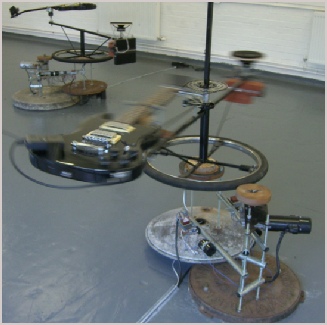
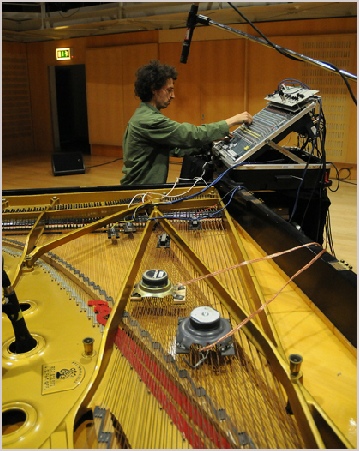
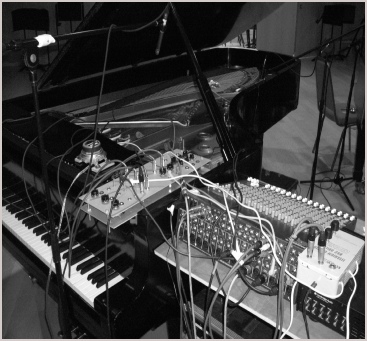
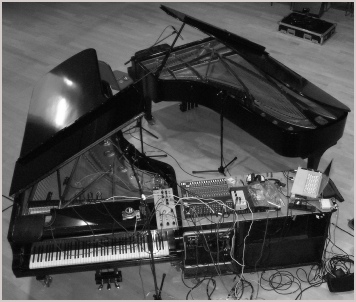
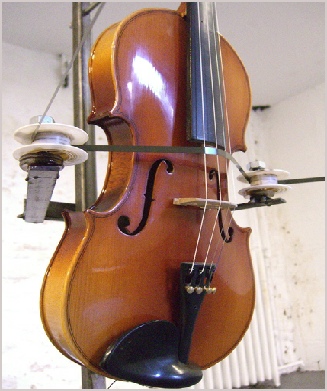
Interview with Stephen Cornford (SC) and Samuel Rodgers (SR) on the background to their duo cd ‘Turned Moment, weighting’ (at-b07), October 2009.
Stephen, you have done a lot of work in sound sculptures & installations. Can you
describe your interest and activities in this area?
SC: I studied sculpture in art
college, so for the last ten years object-making has always been a part of what I
do. Having said that my work had strayed pretty far from sculpture by the time I
got around to working with sound (which probably began in earnest at some point in
2005) and it was actually working with sound that brought me back to sculpture. Around
that time I was getting interested in Process Music, so I started experimenting with
putting instruments through physical processes and very quickly laid down the principles
that would inform my work over the next three years. Those pieces have all been kinetic
sound sculptures, mostly for stringed instruments which are activated by vibration
or motion rather than direct contact. [examples can be found here] I'm interested
in setting up systems which leave all of the details of the sound indeterminate within
the bounds of the system. All of these works have an important relation to the space
they are shown in; I try to create a situation where the piece is unravelled as the
audience move through the space and where any number of people can be having a different
auditory experience at any one time.
I've only seen or heard your sculptures on audio and video recordings, but many of them feature conventional musical instruments – especially the classic ones: piano, violin, electric guitar. Your sculptures use these in very unconventional and radical ways, but I'm struck that you are still engaging with (classical) music history in some way.
SC: This question comes up a lot and I have often cited the iconographic value of these particular instruments in my decision to use them; they are each symbolic of a long tradition and there is a nice subversion inherent in approaching them from a more radical stance. But really that answer belongs to Fluxus and not to me. Even before I worked with sound I had always used found objects, stuff that would have a resonance with viewers, and really the work was in recontextualising those familiar objects, and working with instruments is in some ways a continuation of that. But the classic instruments are also the common ones: it's easy to pick up a crap piano, violin or electric guitar off eBay relatively cheaply and maybe that’s just as valid an answer.
Which artists/musicians in this area have particularly impressed you?
SC: Although
sound sculpture tends to be associated with figures like Harry Bertoia, I really
see Jean Tinguely as the most important historical figure, especially his Meta-Harmonie
series. Tinguely's work has been a massive influence on me. Joe Jones, Paul Panhuysen
and Remko Scha are all quite important to me although I have never seen any of their
work first hand. Nowadays I think Ray Lee, Pierre Berthet, Gordon Monohan, Jean-Pierre
Gauthier, Ernie Althoff and John Wynne are all making really good work in and around
this area.
Sam, what is your background and how did you come to play experimental music?
SR: I came to music relatively late, beginning to learn guitar around 14, then moving on to piano around 16. Having picked up the rudiments of guitar I began improvising; making noises as well as more 'musical' sounds, and making sounds with objects around me. I would say that in a sense this is when I began listening. At this time I was aware of very little experimental music, only really through its appropriation in popular music. As I began learning to play piano I became increasingly interested in composition, and the world of written music opened up before me. For some time I was very much immersed in that world, and following college I went to study Music Composition at Dartington College of Arts. Here very many things changed; my notion of what written music was and could be shifted dramatically, and I began to really get a sense of what I wanted to explore. Alongside this interest in written music I was also improvising with numerous musicians and non-musicians. With time I became increasingly uncomfortable with written music as my primary medium, and began or continued to explore other modes of working (such as recording) as compositional tools.
I am now doing an MA in Time-Based Practices at Dartington, approaching my concerns from a somewhat different angle than previously. Currently no longer working with written music, I'm collecting resonant materials (particularly glass & metals) with which I can make instruments, and exploring the instrumental use of microphones, and the mechanisms of sound sensing and reproduction.
How did your collaboration with Stephen come about?
SR: I was initially only peripherally aware of Stephen's work, occasionally hearing him working in the studio at college, and somehow missing all of his performances. Towards the end of my BA however we ended up talking a little about various things and we swapped cds. A little while after this Stephen suggested we spend a weekend in the studio, and we recorded several hours of improvisations, from which Turned Moment, weighting was lifted and edited by Stephen. Other than that, I have recently made an edit from another section of that Sunday's recordings, which is somewhat different in character and construction (and includes Stephen tinkering inside the piano!)
SC: I remember seeing Samuel in the library photocopying the score for Triadic Memories and being surprised because it’s pretty rare for the undergraduates to engage with that sort of stuff, and that made me want to hear him play. Samuel was one of the only other students who would spend all weekend in the studios playing a piano, so we bumped into each other quite often. When I listened to the cd he gave me I remember thinking how completely opposite his approach was, all these sharp attacks and lots of space when at the time I was pretty focused on making drones. I’m incredibly impatient and was then hard line anti-gestural and Samuel’s playing is very tactile and patient; it was that dichotomy that I hoped would come through if we worked together and I think it does on the disc.

SR: As a pianist, having somehow worked myself into a corner with improvising on the instrument, playing with Stephen's feedback setup opened up an entirely different dialogue than I'd experienced previously. Having a continuum of sound to play with and against brought relief to timbral playing, and provided a means of prolonging and exploring resonance (a particular obsession of mine). The two pianos were placed quite closely together, and this meant that sympathetic vibrations of the strings were particularly pronounced - the recording too makes this very explicit.
It's interesting that Stephen first came across you photocopying a Feldman score. I can certainly hear echoes of Feldman in the spaciousness and quietness of your playing, as well as in the use of simple repetitions. Is his music still a conscious influence?
SR: Morton Feldman was certainly a tremendous influence at one time; his music resonated with my own tactile approach to playing, and, I would say, changed the way that I listen. Some of my earlier compositions are more obviously influenced by him, but I think that the experience of playing his music and listening to it has left an imprint.
One difference from your playing on Turned Moment, weighting and Feldman is that you play relatively few pure piano notes. The sounds you use are mainly being gently transformed by preparations or work inside the piano. Could you describe some of the techniques you're using?
SR: The techniques very much developed over the weekend’s playing. Preparations were mostly improvised as we were playing, adding and removing objects from the piano strings. I often came to work with particular strings, altering their timbre in different ways, with objects, muting and damping. I found that with very slight alterations in dynamic and pressure applied to the strings one could produce subtle variations in the spectrum of a particular pitch so that this would shift with repetition. Another aspect of the preparations was that of balancing; I found preparations slowly shifting as I played, this too lending to variation with repetition, and also occasionally changing more rapidly, leading to ‘dramatic’ turns in our dialogue.
The piano has such a strong history and was pretty much the king of instruments within western music for nearly 300 years. And the keyboard is obviously tied to the western tonal system and offers so little possibility in terms of timbral variation that it's almost surprising that it continues to be widely used in experimental music. Are you aware of, or daunted by, this formidable history when you sit down to play the piano, and how do you deal with its limitations as an instrument? Your description of some of your current work implies that you are moving away from the piano as a sound source: is this true?
SR: Though being aware of and struggling with the tradition and limitations of the instrument, I have found the piano a recurring source of inspiration, primarily because it has such long strings, and produces such long resonances, providing a vehicle in to sound. The restrictions of equal temperament, for example, led to implementation of very limited pitch material in my compositions, in order to draw attention to overtone/pitch interactions. With time I became discontented with this way of working, and though not wishing to abandon the piano, recently I have found it essential to work with other materials and approaches.
Stephen, is performing music very different from working with sound sculptures, or
do you see the two as fundamentally related?
SC: I see performance and installation
as two different approaches to the same issues, whether they end up as installations
or performances is a decision that usually makes itself, depending on the system
that I am working with. My performance pieces share the central concerns of my installations:
process and indeterminacy. My main interest in using piano feedback, for example,
is that it is a fairly uncontrollable musical substance that has the potential to
surprise me as a performer and I have come to think of feedback as a particularly
sculptural substance – in that it is so sensitive to its physical surroundings. I’ve
often thought that the reason I approach performance as the handling of a process
is that it brings me closer to the experience of the listener: by reducing the direct
activity on my part I can focus my attention on the sound. So, yes, they are fundamentally
related.
Which do you find more satisfying?
SC: I haven’t got a preference for one mode over the other. The thing about working with processes is that sometimes they can produce astonishing results and sometimes they can just sound flat and really disappoint you. And that happens both in performance and installation work, when I installed Three Piece in London it sounded brilliant the first day I got it running but two days later at the private view none of that magic happened, and sometimes that can be the difference of a micrometer in the position of the strings. Similarly when I performed at the Arnolfini last month it sounded great in the soundcheck – the room was producing this phasing low tone, but immediately the audience were in the space that tone disappeared altogether. This can be very frustrating to work with, but at the same time a lot of my favourite bits of Turning Moment, weighting are where the unexpected happened.
In much of your work once you've constructed a piece, you step back in terms of human agency and simply let the sound and visual processes that you've set up unfold. I'm interested in the idea that human agency in music should be denied / challenged / limited in some way, but perhaps I have a more conservative approach insofar as the music I like best still tends to be composed / structured with varying degrees of decision-making by the performer/composer. To my ears Turned Moment, weighting does have a structure, and indeed an emotional narrative with variations of intensity / tension. Is this something that you accept within a performance situation, or are you still trying to set up pure processes that go beyond human agency?
SC: I'm definitely not a process purist in the same way that, for example, Alvin Lucier is. Although I love listening to that sort of work, there's also something cold and /or dry about some of it. I'm trying to use that approach to create work which can be lyrical, visceral or emotional as well as interesting on a phenomenological level. When I'm doing solo performances I think of the process as my playing partner; it’s not so much about denying my agency as it is about engaging with the chance products of an unstable musical system and trying to respond to them, to manage them without squashing them, to let them have their space but to know when to intervene. Improvising with people is an entirely different thing, but I still try to let the process have its say in that scenario; part of what was interesting about playing with Samuel was to try to create situations in which his actions could impact on my setup. It’s really important to me not to rule out accident, and to rarely be in total control, but at the end of the day the decisions I make on the mixing desk are not so far removed from those Samuel makes at the keyboard.
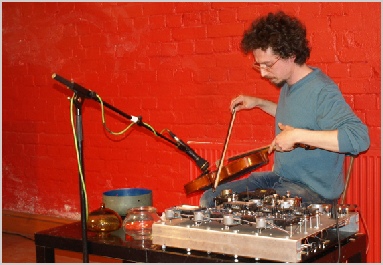
Yes I think your use of feedback in Turned Moment, weighting is interesting. At times the sounds you are producing sound like sine waves, which I personally often find difficult in improvised music, but for me your sounds are more engaging, and I think it's because, as you say, your feedback tones are unstable and less predictable, often shifting or breaking down into impure tones. Is this 'impurity' a quality that you are consciously seeking, or have you used pure sine tones in other work?
SC: I have used sine waves on occasion but as a general rule I try to avoid any generated tone with a fixed pitch. Knowing the exact frequency, timbre and often amplitude of the sound you're about to make is complete anathema to my working methods. Working with the piano I'm constantly searching for new ways to break open that smooth sine-like timbre. Although it was probably the initial attraction of the feedback technique I use, it has now become something I am consciously looking to adulterate. This has mostly been done by the use of preparations but also by using really lo-fi speakers and amps so that distortion becomes a factor too. The eighty-eight keys of the piano pretty much cover the whole frequency range of human hearing but all with these very pure notes. Increasingly one of my aims with this instrument is to develop inside it a means of playing with the whole range of timbral possibilities too, not that there’s anything new about that.
So why the title 'Turned Moment, weighting'?
SC: The title came about through an email exchange which was much in the vein of a word association game, which I won’t regurgitate here, except to say that the definition of a Turning Moment as “the action of a force about a fixed point at a distance from that point” is quite important in my understanding of the title.
SR: The words in the title have numerous connections to aspects of our playing, moments in the recording, and associative connections that we both made. We felt that the title somehow resembled the overall form of the disc, and the variation of tense lends a variety of description, and also had a nice pun (weighting/waiting) that Stephen liked.
When you edited the music from the recording session how much were you constructing / composing / transforming it in post-production, or did you simply select extracts from the improvisations and present them as such?
SC: We'd recorded for a whole weekend, and I had this unmanageable file on my computer, so to begin with I was simply trying to sort the wheat from the chaff, just so that we could listen to some of the good material on its own merits. I restricted myself to using material from three consecutive recordings made on the second day, simply because at the time of playing this had felt to both of us a strong and focused period. As soon as I'd isolated these bits, possible beginnings, endings and transitions suggested themselves, so the only ‘composition’ done was in topping, tailing and then ordering the three recordings. Neither of the first two tracks contain an edit, and the third is simply two sections of different recordings placed side by side. Most of the post production work from there was in balancing the two players, so there has been some tinkering with gain and some filtering to maintain that balance.
Sam, you said earlier that you've done a very different edit from the same recording session. Were you involved in the editing of Turned Moment, weighting at all? And can you say a little more about how your edit of the session differs from Stephen's?
SR: Stephen selected and edited the material heard on the disc soon after we'd recorded, and since then there've been a number of edits and changes. Most of the editing decisions were arrived at between us, and we found that we agreed on most points, many of the decisions seeming almost natural consequences of the material. Stephen did all the actual editing as he'd selected the material and the project was on his computer. The edit that I've done is from the same day’s session, but with different material – there's no overlap at all. The edit was made from one take of around 40 minutes, which I've now reduced to around 20 minutes. I made some rearrangements of material, isolating particular moments, some of which are relatively short. The overall form of this second selection is quite different; there are more pronounced contrasts in our playing, and the movement between moments has a different character.
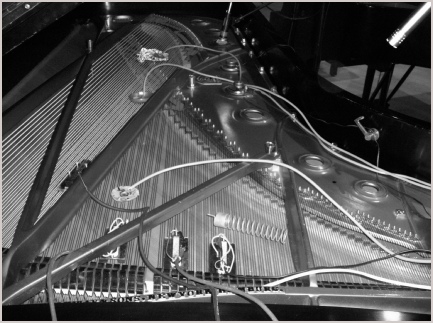
Photographs © Stephen Cornford & Samuel Rodgers


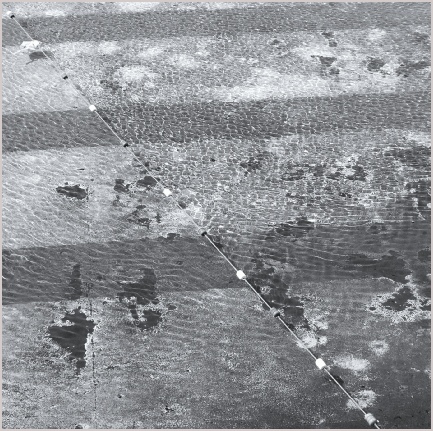
Turned Moment, weighting (at-b07) released January 2010